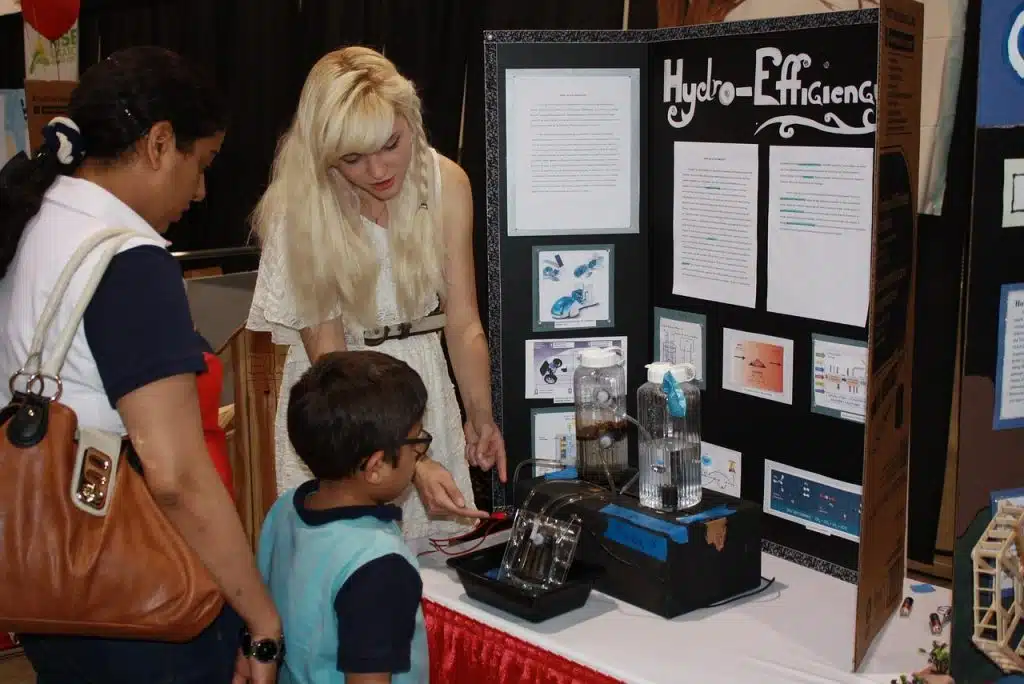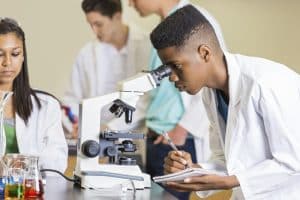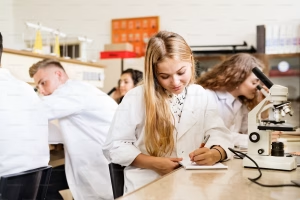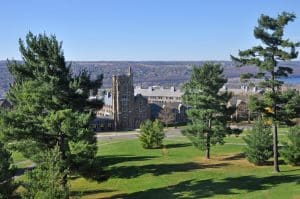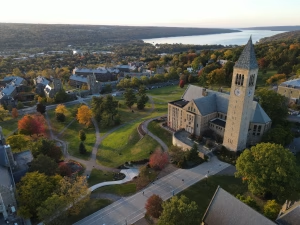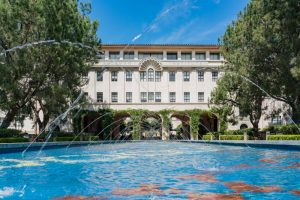Looking for last-minute winning science fair projects for high school? You’ve come to the right place! There are so many projects you can do for a science fair under many categories, from chemistry to environmental science, so it’s understandably hard to settle on just one.
In the article below, we’ll list down several science fair projects divided into categories to give you an idea of the experiments you can consider doing.
- Biology Science Fair Projects
- Physics Science Fair Projects
- Engineering Science Fair Projects
- Computer Science Fair Projects
- Frequently Asked Questions
- Takeaways
Biology Science Fair Projects
Biology is the study of life, from microscopic organisms to complex ecosystems. Because of that, biology science fair projects will involve living organisms or biological processes. These experiments can be about growth, behavior, or interactions, with data analysis and conclusions about living systems. Below are three biology science fair projects you can consider.
1. The effect of different light wavelengths on plant growth
Plants use light for photosynthesis, but different wavelengths of light can have varying effects on their growth. This science fair project will explore how specific light colors influence plant height, leaf development, and overall health. It can be helpful for understanding optimal growing conditions, especially in controlled environments like greenhouses or indoor gardens.
Materials
- Small, fast-growing plants (like radish or spinach)
- LED grow lights in red, blue, green, and white wavelengths
- Plant pots and soil
- Ruler or measuring tape
- Camera for documentation
- Watering can
Experimental procedure
- Divide the plants into four groups.
- Set up the LED grow lights, assigning one color (red, blue, green, and white) to each group.
- Ensure all groups receive equal amounts of water and are kept in a consistent temperature environment.
- Measure and record the height of each plant and the number of leaves at regular intervals (such as every 3 days).
- Document plant growth with photographs.
- Continue the experiment for a set period (maybe 3 weeks).
- Analyze the data and create graphs to compare the growth rates of each group.
You can expect that the plants exposed to red and blue light will show the most significant growth. Green light may result in slower growth, and white light should produce moderate growth.
2. The antibacterial effects of natural substances
Many natural substances, like garlic, honey, and tea tree oil, have been used for their antibacterial properties. This project wants to test their effectiveness against common bacteria, contributing to the search for natural alternatives to antibiotics.
Materials
- Bacterial culture (like E. coli)
- Agar plates
- Sterile cotton swabs
- Garlic cloves, honey, tea tree oil
- Distilled water
- Sterile forceps
- Incubator (optional, but recommended)
- Ruler
- Materials for creating garlic extract
Experimental procedure
- Prepare extracts of the natural substances. In this case, you can create garlic extract by crushing garlic and mixing it with water.
- Inoculate agar plates with the bacterial culture.
- Apply the natural substances to the agar plates using sterile cotton swabs.
- Include a control plate with distilled water.
- Incubate the plates at the appropriate temperature.
- Measure the zones of inhibition (which are clear areas around the substances where bacteria did not grow).
- Record and analyze the data.
Garlic extract and tea tree oil should create larger zones of inhibition, meaning they have stronger antibacterial effects. Honey may also show some antibacterial activity, but likely to a lesser degree.
3. The effect of pH on enzyme activity
Enzymes are biological catalysts that speed up chemical reactions. pH levels can significantly affect enzyme activity since enzymes have optimal pH ranges. This project explores how different pH levels influence the activity of a specific enzyme, specifically catalase.
Materials
- Potato or liver (as a source of catalase)
- Hydrogen peroxide (H₂O₂)
- pH buffers (acidic, neutral, alkaline)
- Test tubes
- pH strips or meter
- Measuring cylinders
- Timer
- Water bath (optional)
Experimental procedure
- Prepare catalase extracts from the potato or liver.
- Set up test tubes with different pH buffers.
- Add the catalase extract to each test tube.
- Add hydrogen peroxide to each test tube and immediately measure the rate of oxygen production. You can do this by measuring the foam height or the time it takes for a reaction to occur.
- Record the data and analyze the results.
The catalase will show the highest activity at its optimal pH, which is around neutral pH. The activity will decrease at more acidic or alkaline pH levels.
Physics Science Fair Projects
Physics studies the fundamental laws of the universe, which include motion, energy, and matter. So, a physics science fair project would involve experiments testing physical principles. You can do projects on mechanics, optics, electricity, or thermodynamics, and analyze quantitative data and physical phenomena. We’ll give you a few physics science fair projects below.
4. Testing the efficiency of different wing designs for paper airplanes
Aerodynamics is one of the basic parts of physics, and understanding how wing design affects flight is especially important in aviation. This last minute science fair project will look at how variations in wing shape, size, and aspect ratio affect the distance and stability of paper airplanes—which can connect to real-world applications in aircraft and drone design.
Materials
- Paper (various weights and sizes)
- Ruler
- Scissors
- Tape
- Measuring tape or laser distance measurer
- Protractor (for measuring angles)
- Fan (optional, for controlled wind conditions)
- Camera or video recorder
Experimental procedure
- Design and construct paper airplanes with different wing shapes (such as delta, swept, and rectangular) while maintaining a consistent body size.
- Create multiple versions of each design.
- Establish a controlled launch environment, like a long hallway or open field.
- Launch each airplane multiple times, measuring the distance traveled and observing the flight stability.
- Record data for each flight, including distance, flight time, and any observations about stability.
- Analyze the data, calculate average distances, and compare the performance of different wing designs.
The delta wing design should show the longest flight distances and the most stable flight patterns thanks to its aerodynamic properties. Meanwhile, variations in wing shape will give you measurable differences in flight distance.
5. The relationship between the angle of incidence and the distance a ball travels off a ramp
If you like launching things into the air, then how about a science fair project about another classic physics concept called projectile motion? This project will examine how the angle of a ramp affects the horizontal distance a ball travels after rolling off it. This relates to principles of kinematics and gravitational acceleration.
Materials
- Ramp (either a wooden board or plastic track is okay)
- Ball (a steel ball or marble is okay)
- Protractor
- Measuring tape
- Cardboard or paper (for marking landing points)
- Level
- Stopwatch (optional, to measure time in the air)
Experimental procedure
- Set up the ramp on a flat surface.
- Adjust the ramp to various angles of incidence (like 15°, 30°, 45°, 60°, 75°).
- Release the ball from the same starting point on the ramp for each trial.
- Mark the landing point of the ball for each trial.
- Measure the horizontal distance traveled by the ball for each angle.
- Repeat each trial multiple times to ensure accuracy.
- Record and analyze the data, creating a graph of angle vs. distance.
The horizontal distance should also increase as the angle of incidence increases, reaching a maximum distance around 45 degrees. After that, the distance will decrease even if the angle keeps increasing.
6. Investigating the efficiency of different materials as thermal insulators
Thermal insulation is an important part of energy efficiency since it affects everything from building design to clothing. This science fair project explores how different materials conduct heat, helping to identify the most effective insulators. It relates to the principles of thermodynamics and heat transfer.
Materials
- Heat source (such as a heat lamp or hot water in a container)
- Thermometer or temperature sensor
- Various insulating materials (cotton, wool, aluminum foil, styrofoam)
- Containers or boxes to hold the heat source and insulation
- Timer
- Ruler
Experimental procedure
- Prepare identical containers, each wrapped with a different insulating material.
- Place the heat source inside each container.
- Measure and record the initial temperature.
- Monitor and record the temperature at regular intervals (such as every 5 minutes) for a set period.
- Analyze the data, creating a graph of temperature vs. time for each material.
- Calculate the rate of heat loss for each material.
Styrofoam should show the slowest rate of heat loss, meaning it’s the most effective insulation. Wool and cotton should also provide some insulation, though less effectively. Meanwhile, aluminum foil may conduct heat, making it a poor insulator.
Engineering Science Fair Projects
Engineering applies scientific and mathematical principles to design and build solutions to real-world problems, so you’ll need to think up projects focused on design, construction, and optimization. This might involve building prototypes, testing materials, or developing systems to improve efficiency or solve other practical challenges. We’ll give you several examples below.
7. Designing and optimizing a solar-powered water purification system
Access to clean drinking water is a big global challenge nowadays. This project will challenge you to design and optimize a cost-effective and efficient solar-powered water purification system. It involves principles of solar energy, heat transfer, and filtration.
Materials
- Parabolic reflector or flat solar panel
- Container for contaminated water
- Piping and tubing
- Filtration materials (sand, gravel, activated carbon, fabric)
- Collection container for purified water
- Thermometer
- Water quality testing kit (optional)
- Materials for constructing the system (wood, metal, plastic)
Experimental procedure
- Design and construct two water purification systems: one with a parabolic reflector and multi-stage filtration, and the other with a flat solar collector and basic filtration.
- Prepare a consistent “contaminated” water sample, such as muddy water.
- Place both systems in direct sunlight for a set period of time.
- Measure the volume of purified water collected from each system.
- Record the temperature of the water at various stages.
- (Optional) Test the water quality of the input and output samples.
- Analyze the data and compare the efficiency of the two designs.
The system with the parabolic reflector and multi-stage filtration should produce a significantly higher volume of purified water because of the concentrated solar energy and enhanced filtration. The water quality should also be improved.
8. Building and testing an automated hydroponic system for urban farming
Urban farming and sustainable agriculture are becoming increasingly important these days. So, this science fair project will focus on designing and building an automated hydroponic system that optimizes plant growth in a controlled environment. It involves principles of automation, electronics, and plant biology.
Materials
- Container for nutrient solution
- Grow lights
- pH sensor and controller
- Nutrient level sensor and controller
- Water pump and tubing
- Microcontroller (Arduino is okay)
- Plants like lettuce or herbs
- Growing medium (like rockwool, coco coir)
- Materials to build a frame
Experimental procedure
- Design and build an automated hydroponic system with sensors and controllers.
- Set up a manual hydroponic system as a control.
- Plant identical seedlings in both systems.
- Monitor and record plant growth (height, leaf count) at regular intervals.
- Record pH and nutrient levels in both systems.
- Analyze the data and compare the growth rates of plants in the automated and manual systems.
Plants grown in the automated hydroponic system should show a significantly higher growth rate because of the precise control of environmental factors.
9. Designing and testing an optimized bridge structure using recycled materials
Civil engineering and structural design are very important in building infrastructure. For this science fair project, you’ll have to design and test an optimized bridge structure using recycled materials, focusing on maximizing strength and minimizing material usage. This project incorporates concepts of structural integrity, material science, and sustainable engineering.
Materials
- Recycled plastic like plastic bottles and containers
- Recycled cardboard
- Adhesive or fasteners
- Weights or load testing equipment
- Measuring tools
- Materials to build a testing platform
Experimental procedure
- Design and construct three bridge structures: one using a truss system with recycled plastic and reinforced cardboard, one using only recycled cardboard, and one using only recycled plastic.
- Set up a testing platform to apply a load to the bridges.
- Gradually increase the load on each bridge until it fails.
- Record the maximum load each bridge can support.
- Analyze the data and compare the structural strength of the different designs.
- Document the failure points of each bridge.
The bridge structure using a truss system with recycled plastic and reinforced cardboard should support the highest load, proving the effectiveness of the optimized design and material combination.
Computer Science Fair Projects
Computer science explores computation, algorithms, and information processing, so projects in this category will involve software development, data analysis, or machine learning. You might design programs, analyze datasets, or create predictive models to show problem-solving through computational methods and algorithms. We’ll discuss several suggestions for possible projects below.
10. Developing a machine learning model for image recognition of plant diseases
Agriculture is important, and early disease detection can save crops. This project challenges you to develop a machine learning model that can accurately identify plant diseases from only images. It uses concepts of image processing, machine learning algorithms (like convolutional neural networks), and data analysis.
Materials
- Dataset of plant leaf images (with and without diseases)
- Computer with a GPU (recommended for faster training)
- Python programming language
- Libraries: TensorFlow or PyTorch, Keras, OpenCV, NumPy, Pandas
- Optional: Image processing software (like GIMP or Photoshop)
Experimental procedure
- Gather and preprocess a dataset of plant leaf images, labeling each image with the corresponding disease (or “healthy”).
- Split the dataset into training, validation, and testing sets.
- Design and train a CNN model using the training data.
- Evaluate the model’s performance using the validation and testing sets, calculating metrics like accuracy, precision, and recall.
- Compare the CNN’s performance to a simpler image classification algorithm (such as using Support Vector Machines or basic neural networks).
- Document the model’s architecture, training process, and results.
The CNN model should have a high accuracy in identifying plant diseases, showing the effectiveness of deep learning for image recognition tasks. The CNN should outperform simpler algorithms.
11. Building a predictive model for stock market trends using time series analysis
Predicting stock market trends is a complicated task that involves analyzing historical data. This project will be about developing a predictive model using time series analysis techniques (like ARIMA or LSTM networks) to predict stock prices. It involves data analysis, statistical modeling, and machine learning.
Materials
- Historical stock market data (such as from Yahoo Finance or Google Finance)
- Computer with Python installed
- Libraries: Pandas, NumPy, Matplotlib, Scikit-learn, TensorFlow or Keras
Experimental procedure
- Collect and preprocess historical stock market data, including closing prices, volume, and other relevant features.
- Split the data into training and testing sets.
- Implement an ARIMA model and an LSTM network to predict future stock prices.
- Train both models using the training data.
- Evaluate the models’ performance using the testing data, calculating metrics like mean squared error (MSE) or root mean squared error (RMSE).
- Compare the prediction accuracy of the ARIMA model and the LSTM network.
- Present the results, including visualizations of the predicted vs. actual stock prices.
The LSTM network should produce more accurate stock price predictions than the ARIMA model thanks to its ability to capture long-term dependencies in time series data.
12. Creating a personalized recommendation system for educational resources
Personalized learning is becoming increasingly important to help students achieve their full potential. So, this project aims to develop a recommendation system that suggests relevant educational resources based on a user’s learning preferences and progress. It involves data analysis, user modeling, and recommendation algorithms (like collaborative filtering or content-based filtering).
Materials
- Dataset of educational resources (like articles, videos, and tutorials) with user ratings or interaction data
- Computer with Python installed
- Libraries: Pandas, NumPy, Scikit-learn, Surprise (for recommendation algorithms)
Experimental procedure
- Collect or create a dataset of educational resources and user interaction data (such as ratings and viewing history).
- Preprocess the data, creating user-item interaction matrices.
- Implement a collaborative filtering algorithm (such as user-based or item-based).
- Implement a basic popularity-based recommendation system as a baseline.
- Train and evaluate both systems using the dataset, calculating metrics like precision, recall, and F1-score.
- Compare the performance of the collaborative filtering algorithm and the popularity-based system.
- Create a simple user interface to demonstrate the recommendation system.
The collaborative filtering algorithm should give more relevant and personalized recommendations, showing its effectiveness in matching users with the right educational resources.
Frequently Asked Questions
1. What is the most prestigious high school science fair?
The Regeneron International Science and Engineering Fair (ISEF) is widely considered the most prestigious high school science fair, attracting top young scientists from around the world.
2. How many levels of science fair are there?
There are five main levels of science fairs: classroom, school-wide, regional, state, and international.
3. How do you win a high school science fair?
To win a high school science fair, you’ll need a well-designed, original project demonstrating scientific rigor. Choose an engaging topic that you genuinely like, research thoroughly, follow the scientific method, present your findings clearly and persuasively, and be confident in Q&A.
Takeaways
Science is a very large field with diverse branches, so it can be hard to easily settle on the type of project to do for a science fair.
- There are countless projects you can do under the different branches of science. These include biology, physics, engineering, and computer science.
- It can be hard to say that you’re doing a national winning science fair project for high school. However, to increase your chances of winning, choose an intriguing topic you’re genuinely curious about, be rigorous in your research and experimentation, and be confident when presenting your findings.
- Are you an aspiring scientist looking for more ways to show your interest in the sciences? A private admissions expert can guide you to more opportunities to boost your college application for a science program.



